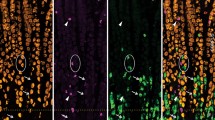Summary
The ultrastructure of gastrin cells in the rat antrum was analyzed with standardized and quantitative planimetric methods. Resting and active cells were compared. The gastrin cells were activated by removal of the acidproducing part of the stomach (fundectomy). As a result the serum gastrin concentrations were greatly elevated. Compared with gastrin cells in fasted control rats the gastrin cells in fundectomized rats were increased in number, contained fewer cytoplasmic granules, increased amount of endoplasmic reticulum, and an enlarged Golgi area.
Generally, the secretory granules of the gastrin cell displayed a wide range of electron density from highly electron-dense to electron-lucent. They exhibited certain characteristic features: 1) Electron-dense granules made up a greater proportion of the total granule population in active gastrin cells than in resting cells. 2) Electron-dense granules were more frequent near the Golgi stacks than in the periphery of the cell. 3) Electron-dense granules were smaller in size than the electron-lucent granules; hence, small electron-dense granules probably represent young granules (progranules), while large, electron-lucent granules represent mature (old) granules. 4) Electron-dense granules invariably displayed a more intense immunoreactivity than electron-lucent granules.
The gastrins are generated from a large precursor molecule. The posttranslational processing of this precursor is reflected in the gastrin-component pattern. The gastrin-component pattern in antral extracts of fundectomized and normal fasting rats differed in that the proportion of the gastrin-4-like component was reduced, whereas the gastrin-34-like component was increased in the fundectomized rats. The results suggest a greater proportion of small gastrin components in the mature granules than in the newly formed ones, presumably due to more extensive conversion of larger forms into smaller forms with a longer granule half-life. As a result gastrin-17-and gastrin-34-like components make up a larger proportion of total gastrin in active gastrin cells than in resting gastrin cells.
Similar content being viewed by others
References
Alumets J, El Munshid HA, Håkanson R, Liedberg G, Oscarson J, Rehfeld JF, Sundler F (1979) Effect of antrum exclusion on endocrine cells of rat stomach. J Physiol 286:145–155
Alumets J, El Munshid HA, Håkanson R, Hedenbro J, Liedberg G, Oscarson J, Rehfeld JF, Sundler F, Vallgren S (1980) Gastrin cell proliferation after chronic stimulation: Effect of vagal denervation or gastric surgery. J Physiol 298:557–569
Bastie MJ, Balas D, Senegas-Balas F, Bertrand C, Pradayrol L, Frexinos J, Ribet A (1979) A cytophysiological study of the G-cell secretory cycle in the antrum mucosa of the hamster and of the rat. Scand J Gastroenterol 14:35–48
Dacheux F, Dubois MP (1976) Ultrastructural localization of prolactin, growth hormone, and luteinizing hormone by immunocytochemical techniques in the bovine pituitary. Cell Tissue Res 174:245–260
Dockray GJ, Vaillant C, Hopkins C (1978) Biosynthetic relationships of big and little gastrins. Nature 273:770–772
Forssmann WG, Orci L (1969) Ultrastructure and secretory cycle of the gastrin-producing cell. Z Zellforsch 101:419–432
Håkanson R, Rehfeld JF, Ekelund M, Sundler F (1981) The life cycle of the gastrin granule. Hepato-Gastroent 28:64–65 (abs)
Kobayashi S, Fujita T (1974) Emiocytotic granule release in the basal-granulated cells of the dog induced by intraluminal application. In: Fujita T (ed) Gastro-entero-pancreatic endocrine system. G Thieme, Stuttgart, pp 49–53
Larsson L-I (1978) Gastrin and ACTH-like immunoreactivity occurs in two ultrastructurally distinct cell types of rat antropyloric mucosa. Histochemistry 58:33–48
Mortensen NJ McM, Morris JF (1977) The effect of fixation conditions on the ultrastructural appearance of gastrin cell granules in the rat gastric pyloric antrum. Cell Tissue Res 176:251–263
Mortensen NJ McM, Morris JF, Owens CJ (1978) Gastrin and the ultrastructure of G cells after stimulation with acetylcholine. Cell Tissue Res 192:513–525
Mortensen NJ McM, Morris JF, Owens CJ (1979) Gastrin and the ultrastructure of G cells in the fasting rat. Gut 20:41–50
Nilsson G, Hjelmquist U, Brodin E (1979) Effect of oral administration of calcium carbonate, Camalox® and Novalucol® on plasma gastrin concentration in duodenal ulcer patients. Acta Pharmacol Toxicol (Kbh) 44:81–84
Noyes BE, Mevaresh M, Stein R, Agarwal KL (1979) Detection and partial sequence analysis of gastrin mRNA by using an oligodeoxynucleotide probe. Proc Natl Acad Sci USA 76:1770–1774
Rehfeld JF (1980) COOH-terminal extended endogenous gastrins. Biochem Biophys Res Commun 92:811–818
Rehfeld JF (1981a) Four basal characteristics of the gastrin-cholecystokinin system. Am J Physiol 240:G255–266
Rehfeld JF (1981b) Tetrin. In: Bloom SR (ed) Gut hormones. Churchill Livingstone Ltd, Edinburgh London, pp 240–247
Rehfeld JF, Uvnäs-Wallensten K (1978) Gastrins in cat and dog: Evidence for a biosynthetic relationship between the large molecular forms of gastrin and heptadecapeptide gastrin. J Physiol 283:379–396
Rehfeld JF, Stadil F, Rubin B (1972) Production and evaluation of antibodies for the radioimmunoassay of gastrin. Scand J Clin Lab Invest 30:221–232
Sato A (1978) Quantitative electron microscopic studies on the kinetics of secretory granules in G-cells. Cell Tissue Res 187:45–59
Stadil F, Rehfeld JF (1973) Determination of gastrin in serum. An evaluation of the reliability of a radioimmunoassay. Scand J Gastroenterol 8:101–112
Sternberger L (1974) Immunocytochemistry. Prentice-Hall Inc, Englewood Cliffs, NJ, USA
Track NS, Creutzfeldt C, Arnold R, Creutzfeldt W (1978) The antral gastrin-producing G-cell: Biochemical and ultrastructural responses to feeding. Cell Tissue Res 194:131–139
Track NS, Creutzfeldt C, Creutzfeldt W (1980) Cellular synthesis and release of gastro-entero-pancreatic hormones. In: Glass GBJ (ed) Gastrointestinal hormones. Raven Press, New York, pp 71–84
Weibel ER (1969) Stereological principles for morphometry in electron microscopic cytology. Int Rev Cytol 26:235–302
Weibel EP, Bolender RP (1973) Stereological techniques for electron microscopic morphometry. In: Hayat MA (ed) Principles and techniques of electron microscopy. Biological applications, Vol 3. Van Nostrand Reinhold Co, New York, pp 237–296
Author information
Authors and Affiliations
Rights and permissions
About this article
Cite this article
Håkanson, R., Alumets, J., Rehfeld, J.F. et al. The life cycle of the gastrin granule. Cell Tissue Res. 222, 479–491 (1982). https://doi.org/10.1007/BF00213849
Accepted:
Issue Date:
DOI: https://doi.org/10.1007/BF00213849




